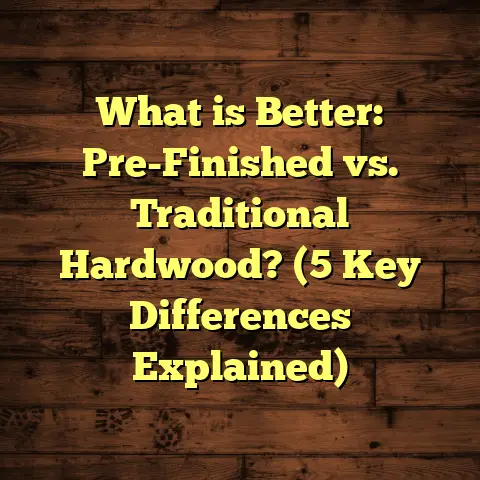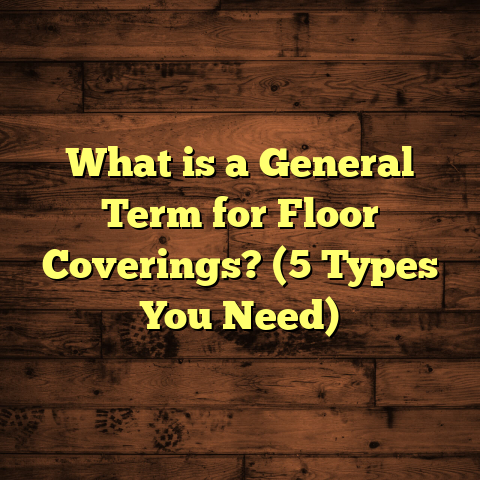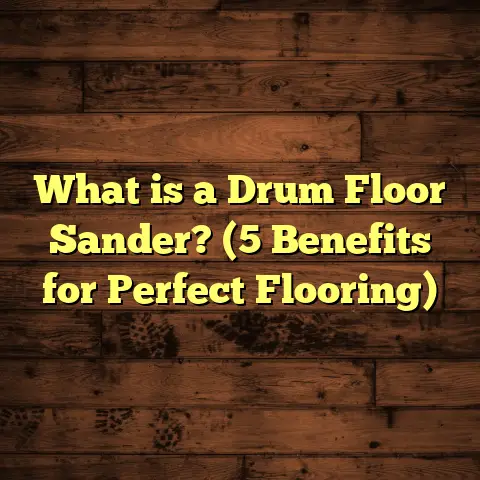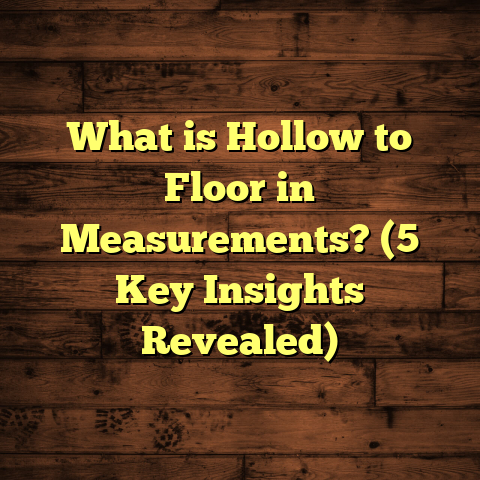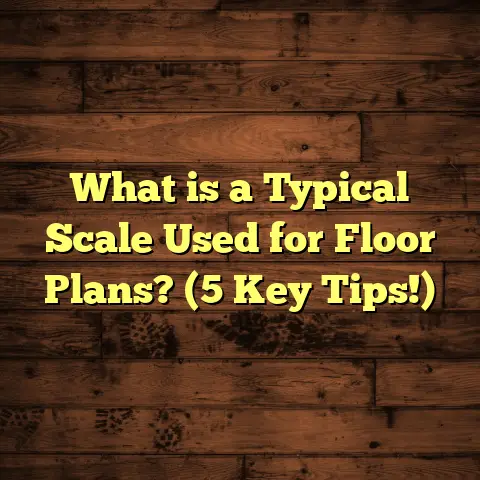What is Waterproof Luxury Vinyl Flooring? (5 Benefits Explained)
What if your floors could handle anything life throws at them—spills, pets tracking in mud, humidity, even accidental flooding—without you needing to stress about costly repairs or time-consuming maintenance? Imagine a flooring option that looks stunning, mimics natural wood or stone flawlessly, yet stands up to real-life challenges better than many traditional materials. That’s the kind of reliability and style I found with waterproof luxury vinyl flooring (LVT/LVP), and I want to share everything I’ve learned about it.
What is Waterproof Luxury Vinyl Flooring?
Let’s get straight to it. Waterproof luxury vinyl flooring is a type of resilient floor covering made from multiple layers engineered to resist water completely. Unlike traditional vinyl that might warp or bubble when exposed to moisture, this flooring has a core that doesn’t absorb water at all. The result? Floors that can survive in moisture-prone areas like kitchens, bathrooms, basements, and even commercial spaces without damage.
The layers typically include:
- Wear layer: A clear, durable top coat protecting against scratches, stains, and wear.
- Printed design layer: High-resolution images of wood grain, stone textures, or other patterns.
- Core layer: The heart of the waterproof function. Often made from rigid or flexible vinyl compounds designed specifically to keep water out.
- Backing layer: Sometimes an attached underlayment for comfort and sound absorption.
From my own experience working with clients and homeowners, this construction means you get the look of hardwood or natural stone but with far less worry about moisture ruining your investment.
When I first started installing flooring over a decade ago, hardwood was often the go-to for upscale homes. But I quickly saw how vulnerable wood was in everyday busy spaces—water stains near sinks, warping from humidity, and costly maintenance. Then luxury vinyl came along with new waterproof technology, and it changed the game completely.
Why Does Waterproof Matter?
You might wonder: isn’t all vinyl water-resistant? The answer is no—not all vinyl flooring is fully waterproof. Traditional vinyl sheet flooring can hold up to moisture better than wood or carpet but sometimes has seams or edges where water seeps in. This can cause swelling underneath or mold growth.
Waterproof luxury vinyl flooring is tested and guaranteed to block water entirely, even if it sits on the surface for days. This level of protection opens up possibilities for rooms where you’d hesitate to use other flooring types.
In one project I managed, a couple wanted new floors in their basement rec room. They had dealt with previous flooding problems that ruined carpet and laminate floors. After installing waterproof LVT planks with tight locking systems and proper subfloor prep, their basement stayed dry and damage-free through multiple heavy rains. This real-life success story showed me how valuable waterproof flooring truly is.
1. Resilience Against Water Damage
Let’s talk about what makes waterproof luxury vinyl flooring such a standout choice: its resistance to water damage. This is not just about standing splashes but the ability to handle long-term exposure without warping, swelling, or developing mold issues.
Personal Anecdote
I remember visiting a family whose toddler loved spilling juice during snack time. Before switching to waterproof luxury vinyl, they struggled with stains soaking into their carpet and hardwood floors. After installation, spills were no longer a panic moment—they simply wiped the floor clean before the juice had a chance to settle.
What Makes It Waterproof?
The secret lies in the core layer. Unlike laminate or engineered hardwood that use wood fibers susceptible to moisture, LVT uses PVC (polyvinyl chloride) and other synthetic materials that don’t absorb water. Some products feature a rigid core (WPC or SPC) reinforced with limestone composites or wood plastic composites—both highly resistant to moisture.
Data Points
- According to a recent survey by Floor Focus Magazine (2023), 75% of homeowners who installed waterproof luxury vinyl reported zero water-related damage after two years.
- Lab tests show some LVT products can remain submerged in water for up to 72 hours without structural changes.
- A report from the National Floor Safety Institute highlights that waterproof vinyl flooring reduces moisture-related slip hazards by maintaining surface integrity better than traditional wood or laminate.
What Does This Mean for Your Home?
If you have kids who bring muddy shoes inside, pets prone to accidents, or live in humid climates, this flooring is practically foolproof against water damage. Even in bathrooms and kitchens—areas traditionally avoided for wood floors—you can enjoy the look without compromise.
2. Easy Maintenance Saves Time and Money
If you’re anything like me, you want your home to look great without spending hours scrubbing floors every week. Waterproof luxury vinyl flooring offers maintenance simplicity few other materials can match.
My Own Cleaning Routine
I’ve installed LVT in my own home’s kitchen and hallway. All it takes is sweeping regularly and mopping occasionally with a mild cleaner—no special treatments required. Unlike hardwood floors that need refinishing every few years or carpets that trap dust and odors, this flooring stays fresh with minimal effort.
Why Is It So Low-Maintenance?
The wear layer on top of waterproof LVT resists scratches and stains effectively. Plus, since liquid doesn’t penetrate the core, spills don’t soak in or cause discoloration. Dust and dirt don’t embed themselves in grooves like on rougher surfaces either.
Cost Savings Over Time
A case study I reviewed from a residential flooring company showed that homeowners saved about 30% annually on floor maintenance after switching from carpet or hardwood to luxury vinyl. No waxing, no polishing, no expensive cleaners required.
Quick Tip
Avoid harsh chemicals like bleach or ammonia; stick with neutral pH cleaners designed for vinyl floors. Also, use felt pads under furniture legs to prevent scratches.
3. Realistic Looks Without the Fragility
One common concern people have about vinyl is that it looks cheap or fake. From my experience installing and seeing many product lines firsthand, this is no longer true with luxury vinyl options today.
How Realistic Can It Get?
Thanks to advances in digital printing technology, manufacturers can replicate natural wood grains, stone veining, and textures with astonishing accuracy. Some brands even emboss textures onto the surface for authentic tactile feel.
For example, one client wanted a rustic oak look but was worried about hardwood upkeep. We chose an LVT plank with deep grain embossing and color variation so realistic they struggled to tell it apart from real wood once installed.
Durability Compared to Natural Materials
While hardwood can scratch easily or tile can crack if dropped on hard objects, luxury vinyl resists dents and chips better. Plus it won’t fade under sunlight as many natural materials might over time.
Style Variety
Whether you want classic oak, sleek marble, weathered barnwood, or even trendy concrete looks—there’s an option available in waterproof luxury vinyl flooring formats. It’s incredibly versatile for any design taste.
4. Comfort and Sound Absorption
Hard surfaces often get a bad rap for being cold and noisy underfoot. I’ve seen clients choose carpet just for warmth and sound dampening—but waterproof luxury vinyl flooring offers good alternatives here too.
Softer Feel Underfoot
Compared to tile or solid hardwoods, LVT tends to have some flexibility thanks to its layered construction. This means it’s gentler on your feet when standing for long periods in kitchens or playrooms.
Sound Reduction Benefits
Some luxury vinyl products come with pre-attached underlayments made of foam or cork material that absorbs sound vibrations. When installing multi-level homes or apartments where noise transfer is a concern, this can be a huge plus.
During one condo renovation project I managed, installing LVT with an integrated underlayment reduced footstep noise by nearly 40% compared to bare concrete subfloors—improving tenant satisfaction greatly.
Additional Comfort Tips
If comfort matters most for you, consider pairing LVT with cushioned underlayment pads where allowed by the manufacturer guidelines.
5. Cost-Effective Flooring Solution
Budgeting for new floors is one of the biggest challenges homeowners face during renovations. I’ve been through countless projects where balancing style, durability, and cost felt like juggling flaming torches.
How I Handle Cost Estimations Now
I started using FloorTally some years ago to streamline my budgeting process. It lets me input room dimensions quickly, pick specific materials like waterproof luxury vinyl flooring from many brands, and generate detailed cost breakdowns including labor rates based on my location.
This has saved me hours of hunting down prices manually and helped clients get transparent estimates upfront instead of surprises later on.
Why This Matters
Flooring projects can easily go over budget if waste factors aren’t considered or if labor costs are miscalculated. FloorTally includes waste percentages depending on plank size and layout complexity—so I always buy just enough material without overspending.
Real Cost Comparisons
- Hardwood floors average $8–$15 per square foot installed.
- Luxury vinyl floors range from $3–$7 per square foot installed.
- Tile can vary widely but often costs $5–$10 per square foot installed.
Given that waterproof LVT offers similar aesthetics with easier maintenance and better moisture resistance at roughly half the cost of hardwood installation in many cases—it’s a practical choice for many budgets.
Installation Insights I’ve Learned Over Time
Getting perfect results with waterproof luxury vinyl flooring depends heavily on good installation practices:
- Subfloor Prep Is Crucial: Floors must be flat within tolerance levels (usually 3/16 inch over 10 feet) and clean of debris.
- Acclimate Flooring: Let planks sit in the room temperature environment 48 hours before installation to avoid expansion issues.
- Use Manufacturer-Approved Adhesives: For glue-down installations especially; floating floors have different requirements.
- Plan Layout Carefully: Account for doorways, transitions, and patterns so cuts are minimal.
- Seal Seams When Needed: In wet areas like showers or commercial kitchens additional seam sealing prevents moisture ingress.
I’ve seen clients try DIY installs without acclimation or subfloor prep—and those floors sometimes buckle or gaps appear after a few months. Taking these steps seriously pays off.
Common Questions I Get About Waterproof Luxury Vinyl Flooring
Can You Install It Over Existing Floors?
Yes! Many LVT products can go directly over existing tile, wood, or concrete provided the surface is level and stable.
Is It Pet-Friendly?
Absolutely! The wear layer resists scratches from claws much better than hardwood or laminate floors.
Does It Feel Cold in Winter?
It can feel cooler than carpet but warmer than tile due to its composition. Adding area rugs helps if needed.
How Long Does It Last?
High-quality waterproof LVT can last 10–20 years depending on foot traffic and care—comparable to mid-range hardwood lifespans.
Final Thoughts
Waterproof luxury vinyl flooring has transformed many homes I’ve worked on by combining beauty with real-world practicality. It handles moisture like a champ, cuts down cleaning time drastically, looks like high-end natural materials without fragility, adds comfort underfoot, and fits budgets well.
If you’re considering new floors for your kitchen, bathroom, basement, or anywhere else prone to moisture—or simply want stylish durable floors without hassle—this option deserves serious thought. And if you want help estimating costs accurately based on your exact space and preferences? Tools like FloorTally have become indispensable for me—and can make your planning much smoother too.
Got questions about styles? Installation tips? Care advice? Just ask—I’m happy to share what I’ve learned from years of hands-on experience working with these fantastic floors.
